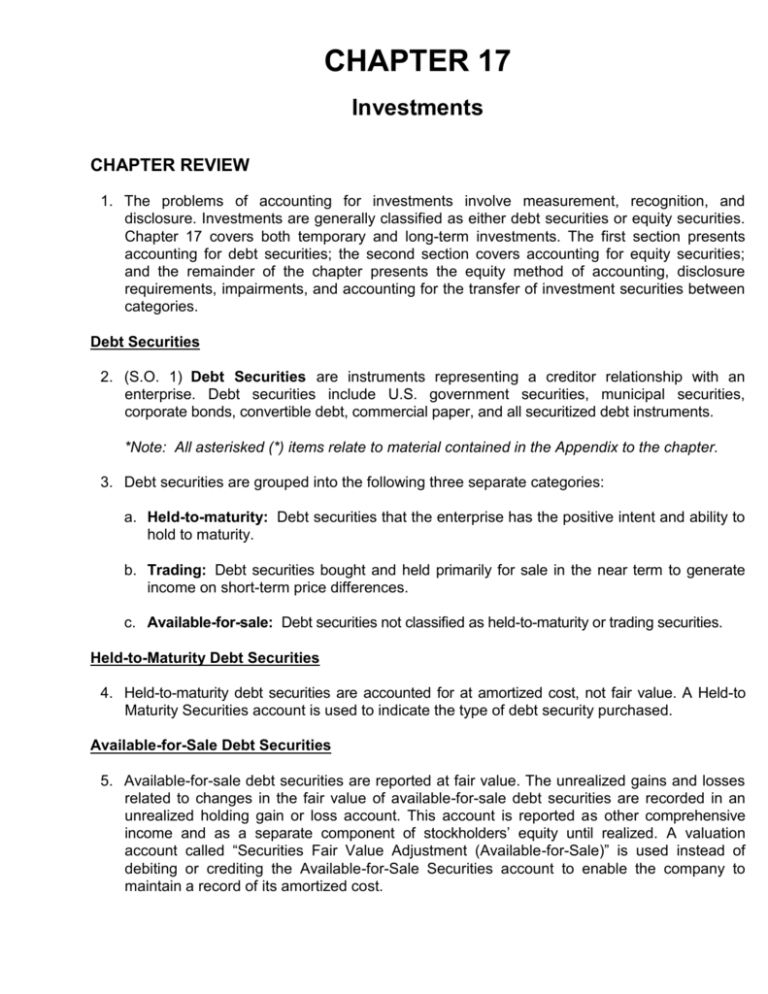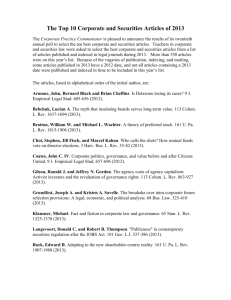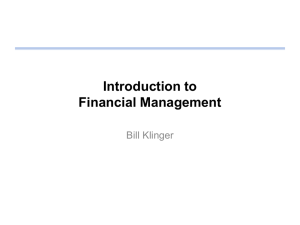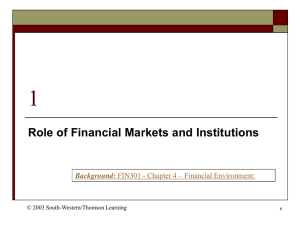Chapter 17
advertisement

CHAPTER 17 Investments CHAPTER REVIEW 1. The problems of accounting for investments involve measurement, recognition, and disclosure. Investments are generally classified as either debt securities or equity securities. Chapter 17 covers both temporary and long-term investments. The first section presents accounting for debt securities; the second section covers accounting for equity securities; and the remainder of the chapter presents the equity method of accounting, disclosure requirements, impairments, and accounting for the transfer of investment securities between categories. Debt Securities 2. (S.O. 1) Debt Securities are instruments representing a creditor relationship with an enterprise. Debt securities include U.S. government securities, municipal securities, corporate bonds, convertible debt, commercial paper, and all securitized debt instruments. *Note: All asterisked (*) items relate to material contained in the Appendix to the chapter. 3. Debt securities are grouped into the following three separate categories: a. Held-to-maturity: Debt securities that the enterprise has the positive intent and ability to hold to maturity. b. Trading: Debt securities bought and held primarily for sale in the near term to generate income on short-term price differences. c. Available-for-sale: Debt securities not classified as held-to-maturity or trading securities. Held-to-Maturity Debt Securities 4. Held-to-maturity debt securities are accounted for at amortized cost, not fair value. A Held-to Maturity Securities account is used to indicate the type of debt security purchased. Available-for-Sale Debt Securities 5. Available-for-sale debt securities are reported at fair value. The unrealized gains and losses related to changes in the fair value of available-for-sale debt securities are recorded in an unrealized holding gain or loss account. This account is reported as other comprehensive income and as a separate component of stockholders’ equity until realized. A valuation account called “Securities Fair Value Adjustment (Available-for-Sale)” is used instead of debiting or crediting the Available-for-Sale Securities account to enable the company to maintain a record of its amortized cost. 6. When an available-for-sale debt security is sold, the realized gain or loss is reported in the Other Revenues and Gains section or the Other Expenses and Losses section of the income statement. Trading Securities 7. Trading securities are reported at fair value, with unrealized holding gains and losses reported as part of net income. A holding gain or loss is the net change in the fair value of a security from one period to another, exclusive of dividend or interest revenue recognized but not received. A valuation account called “Securities Fair Value Adjustment (Trading)” is used instead of debiting or crediting the Trading Securities account. Amortization on Bond Investments 8. (S.O. 2) The effective-interest method is required to amortize premium or discount unless some other method—such as the straight-line method—yields a similar result. The effectiveinterest method is applied to bond investments in a fashion similar to that described for bonds payable. The effective-interest rate or yield is computed at the time of investment and is applied to its beginning carrying amount (book value) for each interest period to compute interest revenue. The investment carrying amount is increased by the amortized discount or decreased by the amortized premium in each period. Equity Securities 9. (S.O. 3) Equity securities are described as securities representing ownership interest such as common, preferred, or other capital stock. They also include rights to acquire or dispose of ownership interests at an agreed upon or determinable price such as warrants, rights, and call options or put options. 10. The degree to which one corporation (investor) acquires an interest in the common stock of another corporation (investee) generally determines the accounting treatment for the investment subsequent to acquisition. Investments by one corporation in the common stock of another and the accounting method to be used can be classified according to the percentage of the voting stock of the investee held by the investor: Holding Method a. Less than 20% Fair Value Method b. Between 20% and 50% Equity Method c. More than 50% Consolidated Statements Fair Value Method 11. When an investor has an interest of less than 20%, it is presumed that the investor has little or no influence over the investee. If market prices are available, the investment is valued and reported subsequent to acquisition using the fair value method. The fair value method requires that companies classify equity securities at acquisition as available-for-sale securities or trading securities. 12. When acquired, available-for-sale equity securities are recorded at cost. Net income earned by the investee is not considered a proper basis for recognizing income from the investment by the investor. Therefore, net income is not considered earned by the investor until cash dividends are declared by the investee. The net unrealized gains and losses related to changes in the fair value are recorded in an Unrealized Holding Gain or Loss-Equity account that is reported as a part of other comprehensive income and as a separate component of stockholders’ equity until realized. The offsetting portion of the entry is debited or credited to the valuation account, Securities Fair Value Adjustment (Available for Sale). 13. The accounting entries to record trading equity securities are the same as for available-for-sale equity securities except for recording the unrealized holding gain or loss. For trading equity securities, the unrealized holding gain or loss is reported as part of net income. Equity Method 14. (S.O. 4) When an investor has a holding interest of between 20% and 50% in an investee corporation, the investor is generally deemed to exercise significant influence over operating and financial policies of the investee. The FASB has also listed other factors to consider in determining whether an investor can exercise “significant influence” over an investee. In instances of “significant influence,” the investor is required to account for the investment using the equity method. 15. Under the equity method the investment’s carrying amount is periodically increased (decreased) by the investor’s proportionate share of the earnings (losses) of the investee and decreased by all dividends received by the investor from the investee. The investor must record as separate components the amount of ordinary and extraordinary income as reported by the investee. 16. Under the equity method, if an investor’s share of the investee’s losses exceeds the carrying amount of the investment, the investor should discontinue applying the equity method and not recognize additional losses (unless the investor’s loss is not limited or if return to profitability appears to be assured). 17. The following transactions illustrate the journal entries for an investment accounted for under the equity method. a. On 1/3/09 Workowski Corporation purchased 55,000 shares (26%) of Wendy Company at a cost of $8 per share. Investment in Wendy Company ........................ Cash ............................................................ 440,000 440,000 b. At the end of 2009 Wendy Company reported net income of $350,000 (all ordinary). Workowski’s share is $91,000 ($350,000 x .26). Investment in Wendy Company ........................ Revenue from Investment ........................... 91,000 91,000 c. In early 2010, Wendy Company paid a $75,000 dividend. Workowski’s share is $19,500 ($75,000 X .26). Cash ................................................................. Investment in Wendy Company ................... 19,500 19,500 d. Wendy Company reported a $215,000 net loss (all ordinary) in 2010. Workowski’s share is $55,900. Loss on Investment ........................................... Investment in Wendy Company ................... 55,900 55,900 Consolidated Financial Statements 18. When one corporation (the parent) acquires a voting interest of more than 50% in another corporation (the subsidiary), the investor corporation is deemed to have a controlling interest. When the parent treats the subsidiary as an investment, consolidated financial statements are generally prepared. The subject of when and how to prepare consolidated financial statements is discussed extensively in advanced accounting. Fair Value Option 19. Companies have the option to report most financial assets and liabilities at fair value, with gains and losses reported in net income. The fair value option is only available at the acquisition date or date incurred, and applies on a security-by-security basis. When the fair value option in selected, it must be used for the life of the instrument. 20. When the fair value option is used for a. Available-for-sale securities, gains and losses related to changes in fair value are reported in net income (rather than as part of comprehensive income). b. Equity method investments, the investor does not report it share of the investee income or loss, rather, changes in the fair value of the investment are reported in net income. Likewise, the receipt of dividends would be recorded as dividend revenue rather than as a reduction of the investment account. c. Financial liabilities, a company revalues its own liabilities, with gains and losses reported in net income. That is, when the market price of a company’s bonds declines, the company will reduce the liability and record a gain in the income statement. Impaired Investments 21. (S.O. 6) Each period every investment must be evaluated to determine if it has suffered a loss in value that is other than temporary (an impairment). If an investment is deemed impaired, the cost basis of the individual security is written down to a new cost basis. The amount of the writedown is accounted for as a realized loss and, therefore, included in net income. Reclassification Adjustments 22. (S.O. 7) As indicated, unrealized holding gains and losses related to available-for-sale securities are reported as part of other comprehensive income. The reporting of changes in unrealized gains or losses in comprehensive income is straightforward unless securities are sold during the year—then a reclassification adjustment is necessary to ensure that gains and losses are not counted twice. Transfers Between Categories 23. (S.O. 8) Transfers between any of the investment categories are accounted for at fair value. The text gives an illustration of measurement basis and how Stockholders’ Equity and Net Income are impacted upon a transfer between investment categories. ILLUSTRATION 17-1 ACCOUNTING FOR DEBT SECURITIES BY CATEGORY ILLUSTRATION 17-2 SCHEDULE OF INTEREST REVENUE AND BOND DISCOUNT AMORTIZATION—EFFECTIVE INTEREST METHOD ILLUSTRATION 17-3 ACCOUNTING AND REPORTING FOR EQUITY SECURITIES BY CATEGORY ILLUSTRATION 17-4 ACCOUNTING FOR TRANSFERS ILLUSTRATION 17-5 SUMMARY OF TREATMENT OF MAJOR DEBT AND EQUITY SECURITIES







